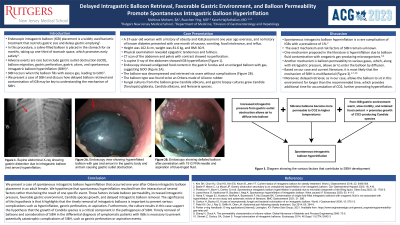Tuesday Poster Session
Category: Interventional Endoscopy
P3757 - Delayed Intragastric Balloon Retrieval, Favorable Gastric Environment, and Balloon Permeability Promote Spontaneous Intragastric Balloon Hyperinflation
Tuesday, October 24, 2023
10:30 AM - 4:00 PM PT
Location: Exhibit Hall

Has Audio

Mahinaz Mohsen, BA
Rutgers New Jersey Medical School
Newark, NJ
Presenting Author(s)
Mahinaz Mohsen, BA, Ruochen Ying, MD, Kaveh Hajifathalian, MD, MPH
Rutgers New Jersey Medical School, Newark, NJ
Introduction: Endoscopic intragastric balloon (IGB) placement is a widely used type of bariatric treatment that restricts gastric size and delays gastric emptying. A saline-filled balloon is placed in the stomach, taking up one-third of stomach space, which promotes early satiety. Spontaneous intragastric balloon hyperinflation (SIBH) occurs when the balloon fills with excess gas, leading to gastric outlet obstruction (GOO). We present a case of SIBH and discuss how delayed balloon retrieval and contamination of IGB may be key to understanding the mechanism of SIBH.
Case Description/Methods: A 37-year-old woman with history of obesity and IGB placement 1 year ago overseas presented with 1 month of nausea, vomiting, food intolerance, and reflux. Vitals were stable. Height was 162.6 cm, and weight was 81.6 kg (BMI 30.9). Physical examination revealed epigastric tenderness and fullness. CT abdomen showed no perforation. Supine X-ray abdomen showed IGB hyperinflation (Figure 1). Endoscopy showed undigested food content in the gastric fundus and enlarged balloon with gas, suggesting GOO (Figure 2). The balloon was decompressed and then retrieved via snare without complications (Figure 3). Fungal cultures from the balloon fluid grew Candida albicans and biopsy cultures grew Candida (Torulopsis) glabrata, Candida albicans, and Neisseria species.
Discussion: The mechanism and risk factors of SIBH remain unknown as it is a rare complication of IGB placement. Our case shows that delayed removal may play a role. Balloon permeability and intragastric pressure from GOO allow air to diffuse into the balloon. Additionally, many commercial balloons are made of silicone, which is more permeable to CO2 than other materials. Permeability to CO2 also increases with temperature. The gastric environment post-IGB both favors CO2 diffusion, and promotes CO2-producing Candida growth given its warmer temperatures, slow motility, and retained food content. Moreover, delayed retrieval provides more time for accumulation of CO2, further promoting the development of hyperinflation. The culture results in this case support the hypothesis that growth of candida species is an important component in the pathogenesis of SIBH. Furthermore, timely removal of balloons and consideration of SIBH in the differential diagnosis of symptomatic patients with IGBs is necessary to prevent complications of SIBH such as gastric perforation or aspiration events.

Disclosures:
Mahinaz Mohsen, BA, Ruochen Ying, MD, Kaveh Hajifathalian, MD, MPH. P3757 - Delayed Intragastric Balloon Retrieval, Favorable Gastric Environment, and Balloon Permeability Promote Spontaneous Intragastric Balloon Hyperinflation, ACG 2023 Annual Scientific Meeting Abstracts. Vancouver, BC, Canada: American College of Gastroenterology.
Rutgers New Jersey Medical School, Newark, NJ
Introduction: Endoscopic intragastric balloon (IGB) placement is a widely used type of bariatric treatment that restricts gastric size and delays gastric emptying. A saline-filled balloon is placed in the stomach, taking up one-third of stomach space, which promotes early satiety. Spontaneous intragastric balloon hyperinflation (SIBH) occurs when the balloon fills with excess gas, leading to gastric outlet obstruction (GOO). We present a case of SIBH and discuss how delayed balloon retrieval and contamination of IGB may be key to understanding the mechanism of SIBH.
Case Description/Methods: A 37-year-old woman with history of obesity and IGB placement 1 year ago overseas presented with 1 month of nausea, vomiting, food intolerance, and reflux. Vitals were stable. Height was 162.6 cm, and weight was 81.6 kg (BMI 30.9). Physical examination revealed epigastric tenderness and fullness. CT abdomen showed no perforation. Supine X-ray abdomen showed IGB hyperinflation (Figure 1). Endoscopy showed undigested food content in the gastric fundus and enlarged balloon with gas, suggesting GOO (Figure 2). The balloon was decompressed and then retrieved via snare without complications (Figure 3). Fungal cultures from the balloon fluid grew Candida albicans and biopsy cultures grew Candida (Torulopsis) glabrata, Candida albicans, and Neisseria species.
Discussion: The mechanism and risk factors of SIBH remain unknown as it is a rare complication of IGB placement. Our case shows that delayed removal may play a role. Balloon permeability and intragastric pressure from GOO allow air to diffuse into the balloon. Additionally, many commercial balloons are made of silicone, which is more permeable to CO2 than other materials. Permeability to CO2 also increases with temperature. The gastric environment post-IGB both favors CO2 diffusion, and promotes CO2-producing Candida growth given its warmer temperatures, slow motility, and retained food content. Moreover, delayed retrieval provides more time for accumulation of CO2, further promoting the development of hyperinflation. The culture results in this case support the hypothesis that growth of candida species is an important component in the pathogenesis of SIBH. Furthermore, timely removal of balloons and consideration of SIBH in the differential diagnosis of symptomatic patients with IGBs is necessary to prevent complications of SIBH such as gastric perforation or aspiration events.

Figure: Figure 1 shows supine abdominal X-ray showing gastric distention due to intragastric balloon (red arrow) hyperinflation.
Figure 2 shows endoscopy showing hyperinflated balloon with gas in the gastric body and antrum causing gastric outlet obstruction.
Figure 3 shows endoscopy showing deflated balloon after penetration with 19 G FNA needle and aspiration of blue-tinged fluid.
Figure 2 shows endoscopy showing hyperinflated balloon with gas in the gastric body and antrum causing gastric outlet obstruction.
Figure 3 shows endoscopy showing deflated balloon after penetration with 19 G FNA needle and aspiration of blue-tinged fluid.
Disclosures:
Mahinaz Mohsen indicated no relevant financial relationships.
Ruochen Ying indicated no relevant financial relationships.
Kaveh Hajifathalian indicated no relevant financial relationships.
Mahinaz Mohsen, BA, Ruochen Ying, MD, Kaveh Hajifathalian, MD, MPH. P3757 - Delayed Intragastric Balloon Retrieval, Favorable Gastric Environment, and Balloon Permeability Promote Spontaneous Intragastric Balloon Hyperinflation, ACG 2023 Annual Scientific Meeting Abstracts. Vancouver, BC, Canada: American College of Gastroenterology.

